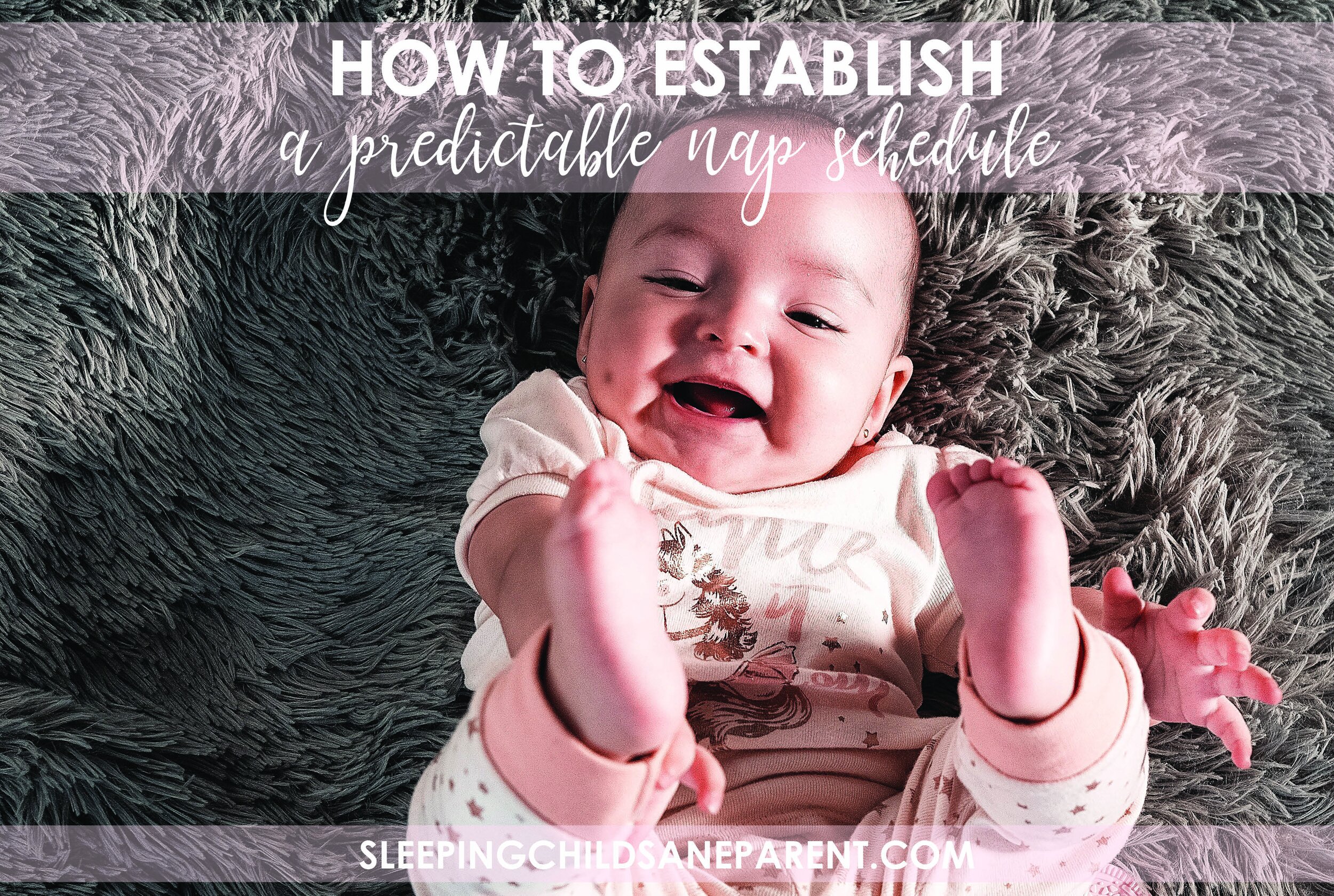Ahh, a predictable nap schedule! That’s the dream, isn’t it? Because when nap time and nap length fluctuate from day to day, it’s enough to make any mama feel crazy, amiright?
The good news is, a predictable nap schedule IS a thing, and you CAN get there!
While a concrete schedule (with the same times daily), is usually only attainable for babies 6+ months old, there are definitely steps you can take to improve Baby’s naps and overall sleep in those first six months (even from day 1!), so if you’re struggling with naps for your younger baby, start here.
But if your baby is 6+ months and you’re ready for predictability, today’s post dives deep into HOW to move from the more sporadic schedule that accompanies the first six months, to the predictable schedule you’ve been craving!
Let’s Start with the Whys
Why the Sporadic Schedule?
Until Baby is developmentally ready for a by-the-clock schedule, I use waketimes, or a set amount of time between naps, to determine nap time. When the Baby wakes up in the morning (or after a nap) later or earlier than usual, the rest of the day shifts, too, thus creating the sporadic schedule.
Prior to 6 months, Baby’s nap success is based purely on finding the right level of sleep pressure — that is, Baby needs to be at just the right level of tired in order to take a 60+ minute nap. If Baby is overtired, he’ll likely take a short nap. If Baby is undertired, he’ll likely take a short nap! Finding the right waketime means finding the sweet spot when it comes to sleep pressure.
Baby’s sleep is also still immature — meaning that even if you find the “perfect” waketimes, sometimes Baby will take a short nap for seemingly no reason!
Baby’s sleep needs are also changing all the time in the first six months, so anytime he’s transitioning to needing a bit less sleep, his days will likely look quite different from one to the next!
Why does it change?
Around 6 months, Baby’s circadian rhythms begin to emerge. Circadian rhythms are internal clocks that tell our bodies when to sleep and when to be awake. These rhythms are determined by exposure to sunlight, along with surges and dips in various hormones. Once these circadian rhythms begin to emerge, we’re no longer relying on ONLY sleep pressure. Sleep pressure is still part of the equation, but it’s not the only factor! This is good news, and we’re able to use these emerging rhythms to our advantage!
Before Transitioning
Prerequisites
In order to switch over to a set schedule, Baby must either be 8+ months old OR 6+ months and consistently taking naps that are 60+ minutes each (nap 3 can be 30-45 minutes — that’s typical).
As I mentioned earlier, the circadian rhythms are only beginning to emerge at 6 months, so if Baby hasn’t been a great sleeper so far, he usually doesn’t do as well being thrown into a by-the-clock (BTC) schedule. By the time he’s 8 months old, you’re usually safe to make the switch right away, even if he’s been a bad sleeper thus far.
If you’ve been working on sleep from the start (perhaps using my Dream Key sleep guides to establish a good sleep foundation and good sleep skills), and Baby is already taking fairly predictable naps, you can begin the transition to BTC naps right around 6 months (adjusted age, meaning 6 months from DUE date).
Consider the factors
When planning the BTC schedule, we need to factor in 4 things: sleep needs, sleep pressure, typical circadian rhythm timing, and Baby’s natural patterns.
Sleep Needs: Baby only needs a certain amount of sleep in a 24-hour period. We want night sleep to total 11-12 hours of sleep, and day sleep to complete the daily sleep needs (based on age; also varies by baby). If Baby’s naps start to get too long, they will take away from night sleep. Night sleep is more restorative and beneficial than day sleep, so we want to prioritize night sleep over long naps. Therefore, it may be necessary to wake Baby from naps on the new schedule.
Sleep Pressure: While sleep pressure is no longer the only factor, it’s still a factor! If Baby required 2 hours of awake time between naps prior to this transition, Baby still typically requires 2 hours of awake time between naps after this transition.
Typical Circadian Rhythm Timing: Typical CR timing dictates that Baby should be laid in his crib for nap 1 between 8:45 and 9am, and for nap 2 between 12:45 and 1pm.
Baby’s Natural Patterns: If Baby is an early bird or a night owl, you may need to select a shifted circadian schedule. ~9am and ~1pm are typically compatible with a 6:30/7am wakeup, so if your Baby wakes more than 15 minutes earlier or later, you’ll likely need to shift the nap timing a bit.
Making the Transition
balance waketimes with circadian rhythms
In the beginning of the transition, we need to balance the old waketimes with the new circadian rhythms.
So let’s say Baby is an average 6-month-old, who typically wakes around 6:30/7am, and whose waketimes prior to the transition are 2 / 2 / 2.25 / 2.5.
If Baby wakes up at 6:30am, a 2-hour waketime would put his first nap at 8:30am. We’re shooting for 8:45/9am, and it’s only a 15-minute stretch to get to 8:45am, so that’s what we’ll do — lay him down at approximately 8:45am.
If Baby wakes up at 7:00am, we’ll put him down closer to 9am to maintain that 2-hour waketime. This is a case where you’d factor in sleep pressure and you’d actually wake Baby by 7am to make sure he gets at least 2 hours of awake time before his first nap is supposed to occur.
If Baby wakes up at 6am, it might be too much of a stretch to get to 8:45am, so we’d watch him for sleepy signs but aim to put him down no earlier than 8:15am (a slightly stretched 2.25 WT), but ideally we’d stretch him a little further, closer to 8:30am.
The same rules would apply for the second nap — stretch a little if necessary, but not too much; and wake Baby from nap 1 to preserve nap 2 if necessary.
Remember Sleep Needs
When it comes to the third nap and/or bedtime, this is where we take into account Baby’s sleep needs, and therefore where there is still some flexibility in the day.
A typical 6-month-old needs ~15 hours of sleep in a 24-hour period, leaving ~9 hours awake. I advise holding onto 3 naps until closer to 8/9 months, so let’s say our example Baby still has 3 naps (and 4 waketimes).
If Baby ends up having two 2.5-hour waketimes in the morning (before naps 1&2), the waketimes in the afternoon will need to be a little shorter (more like 2 hours each) so that Baby doesn’t get overtired. [2.5 + 2.5 + 2 + 2 = 9.]
If Baby’s waketimes in the morning are shorter (say 2 and 2.25), the waketimes in the afternoon will need to be longer so that Baby spends enough time awake during the day (say 2.25 and 2.5). [2 + 2.25 + 2.25 + 2.5 = 9.]
Remember — it’s a Transition
AKA, it may be rough. Transitions usually are! But hang in there, and stay consistent with the changes.
After a week or two of balancing CR with WT, lean into the circadian rhythms more than before. We were already favoring them over waketimes, but now we’re going to favor them even more. Again, this may be rough! But it may not be as rough as you fear.
With Holly, this transition took only one week! During that week, naps were a little bit more sporadic than they were before (meaning, she actually took short naps more often), but then she adjusted and began taking predictable (and long!) naps every single day! Your transition might take only one week, too :)
PHEW — that was a long one.
If you’re feeling overwhelmed and confused and like you need help with this transition, that’s what I’m here for! I take the overwhelm and confusion out of it by talking you through it and helping you figure out exactly how this transition will look for YOUR child.
Click here for more info on how I can help you get the predictable schedule you’ve been longing for!


